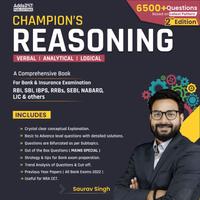Directions (1-5): The question given below consists of two statements numbered I and II given below it. You have to decide whether the data provided in the statements are sufficient to answer the question. Read all the statements and give answer.
Q1. Seven boxes i.e., W, E, R, S, D, F, and G are placed one above other. Which of the following box is placed at fourth position from top?
Statements:
I. Two boxes are placed between G and E. One box is placed between G and W in which W is placed above G. S is placed above G but not just above. More than three boxes are placed between E and S.
II. F is placed just above G. Two boxes are placed between F and D. One box is placed below D. Two boxes are placed between G and S but S does not place below D.
(a) The data in statement I alone are sufficient to answer the question, while the data in statement II alone are not sufficient to answer the question.
(b) The data in statement II alone are sufficient to answer the question, while the data in statement I alone are not sufficient to answer the question.
(c) The data either in statement I alone or in statement II alone are sufficient to answer the question.
(d) The data given in statements I and II together are not sufficient to answer the question.
(e) The data in statements I and II together are necessary to answer the question.
Q2. Who among the following is the second fastest?
Statements:
I. In seven friends, G is faster than U and slower than T. H is not as fast as F. F is slower than U.
II. In seven friends, E is faster than W and slower than Y. Two friends are slower than W. M is not as slow as L. Y is not as fast as L.
(a) The data in statement I alone are sufficient to answer the question, while the data in statement II alone are not sufficient to answer the question.
(b) The data in statement II alone are sufficient to answer the question, while the data in statement I alone are not sufficient to answer the question.
(c) The data either in statement I alone or in statement II alone are sufficient to answer the question.
(d) The data given in statements I and II together are not sufficient to answer the question.
(e) The data in statements I and II together are necessary to answer the question.
Q3. Six friends i.e., C, V, J, Y, T and R have seated around a circular table and facing towards center. Who among the following sits to the immediate left of J?
Statements:
I. One friend sits between C and V. Two friends sit between V and T. Not more than one person sits between T and J (from either side). J does not sit near to V.
II. One person sits between R and T. V sits second to the left of C. T sits to the immediate right of C.
(a) The data in statement I alone are sufficient to answer the question, while the data in statement II alone are not sufficient to answer the question.
(b) The data in statement II alone are sufficient to answer the question, while the data in statement I alone are not sufficient to answer the question.
(c) The data either in statement I alone or in statement II alone are sufficient to answer the question.
(d) The data given in statements I and II together are not sufficient to answer the question.
(e) The data in statements I and II together are necessary to answer the question.
Q4. The persons M, N, O, P, Q and R live on different floor of a six-storey building in which the bottommost floor is numbered as 1 and topmost floor is numbered as 6. Who lives on third floor?
Statements:
I. Two persons live above M. O lives immediately above N. Two persons live between M and P.
II. R lives three floors above O. One person lives between O and P. M lives two floors above N who lives adjacent to P.
(a) The data in statement I alone are sufficient to answer the question, while the data in statement II alone are not sufficient to answer the question.
(b) The data in statement II alone are sufficient to answer the question, while the data in statement I alone are not sufficient to answer the question.
(c) The data either in statement I alone or in statement II alone are sufficient to answer the question.
(d) The data given in statements I and II together are not sufficient to answer the question.
(e) The data in statements I and II together are necessary to answer the question.
Q5. Six boxes (G, H, I, J, K, and L) are kept one above the other, such that the bottommost box is numbered as 1, the box above it as 2 and so on. How many boxes are kept between I and K?
Statements:
I. L is two boxes above G. K is below G. J is two boxes above K. K is not an even numbered box. I is kept above H which not the bottommost box.
II. H is kept immediately below J. Three boxes are kept between H and L. H is an even numbered box. I is kept above K. G is not prime numbered box. K is not an even numbered box.
(a) The data in statement I alone are sufficient to answer the question, while the data in statement II alone are not sufficient to answer the question.
(b) The data in statement II alone are sufficient to answer the question, while the data in statement I alone are not sufficient to answer the question.
(c) The data either in statement I alone or in statement II alone are sufficient to answer the question.
(d) The data given in statements I and II together are not sufficient to answer the question.
(e) The data in statements I and II together are necessary to answer the question.
Solutions

S2. Ans. (b)
Sol. From statement II alone: M > L > Y > E > W > ___ > ____
Hence, the data in statement II alone are sufficient to answer the question, while the data in statement I alone are not sufficient to answer the question.


. .





 GA Capsule for SBI Clerk Mains 2025, Dow...
GA Capsule for SBI Clerk Mains 2025, Dow...
 The Hindu Review October 2022: Download ...
The Hindu Review October 2022: Download ...
 Bank of Baroda Apprentice Recruitment 20...
Bank of Baroda Apprentice Recruitment 20...





